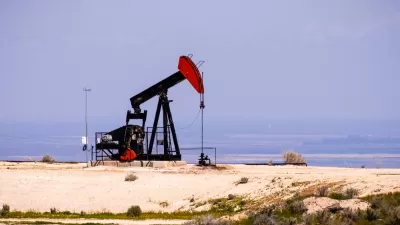This in-depth look at the future of energy shows a coming crisis, with the oil shortage taking center stage due to India and China's thirst for cars. The U.S. sets a poor example for them to follow with low fuel taxes and long commutes.
"The planet's population is expected to grow by 50 percent to nine billion by sometime in the middle of the century.
The number of cars and trucks is projected to double in 30 years- to more than two billion - as developing nations rapidly modernize.
Oil now accounts for just 19 percent of China's energy needs. But China's oil demand is expected to more than double by 2030 to over 16 million barrels a day, according to the International Energy Agency, as more people rise from poverty.
Just as in the United States, much of the increase in China's oil demand has come from that country's love affair with cars. The number of vehicles in China rose sevenfold between 1990 and 2006, to 37 million.
William Chandler, an energy expert at the Carnegie Endowment for International Peace, estimates that if the Chinese were using energy like Americans, global energy use would double overnight and five more Saudi Arabias would be needed just to meet oil demand.
"What about the United States? The country has shown little willingness to address its energy needs in a rational way.
The United States is the only major industrialized nation to see its oil consumption surge since the oil shocks of the 1970s and 1980s. This can partly be explained by the fact that the United States has some of the lowest gasoline prices in the world, the least fuel-efficient cars on the roads, the lowest energy taxes, and the longest daily commutes of any industrialized nation. The result: about a quarter of the world's oil goes to the United States every day, and of that, more than half goes to its cars and trucks."
Thanks to Mark Boshnack
FULL STORY: Barreling Along: The Big Thirst

Manufactured Crisis: Losing the Nation’s Largest Source of Unsubsidized Affordable Housing
Manufactured housing communities have long been an affordable housing option for millions of people living in the U.S., but that affordability is disappearing rapidly. How did we get here?

Americans May Be Stuck — But Why?
Americans are moving a lot less than they once did, and that is a problem. While Yoni Applebaum, in his highly-publicized article Stuck, gets the reasons badly wrong, it's still important to ask: why are we moving so much less than before?

Research Shows More Roads = More Driving
A national study shows, once again, that increasing road supply induces additional vehicle travel, particularly over the long run.

Judge Halts Enforcement of Anti-Homeless Laws in Grants Pass
The Oregon city will be barred from enforcing two ordinances that prosecute unhoused residents until it increases capacity and accessibility at designated camping sites.

Advancing Sustainability in Los Angeles County Schools
The Los Angeles County Office of Education’s Green Schools Symposium brings together educators, students, and experts to advance sustainability in schools through innovative design, climate resilience strategies, and collaborative learning.

Using Old Oil and Gas Wells for Green Energy Storage
Penn State researchers have found that repurposing abandoned oil and gas wells for geothermal-assisted compressed-air energy storage can boost efficiency, reduce environmental risks, and support clean energy and job transitions.
Urban Design for Planners 1: Software Tools
This six-course series explores essential urban design concepts using open source software and equips planners with the tools they need to participate fully in the urban design process.
Planning for Universal Design
Learn the tools for implementing Universal Design in planning regulations.
City of Moreno Valley
Institute for Housing and Urban Development Studies (IHS)
City of Grandview
Harvard GSD Executive Education
NYU Wagner Graduate School of Public Service
City of Cambridge, Maryland
Newport County Development Council: Connect Greater Newport




























